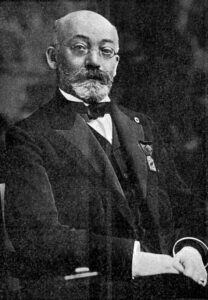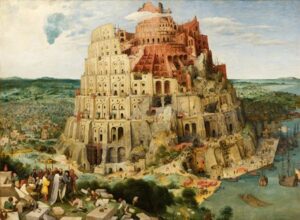Simon Wein
Petach Tikvah, Israel
 |
| L.L. Zamenhof |
L.L. Zamenhof (1859–1917) was an ophthalmologist and philologist from Białystok, then in Russia, now Poland. In the 1880s, he created a new language called Esperanto. The word Esperanto comes from the Latin, spiro, which means “to breathe.” Spiro also means one who hopes. Thus, loosely translated, Esperanto means “where there is life (breath), there is hope.”
This reflected well Zamenhof’s philosophy to unite the world and reduce conflict. In 1914 he wrote, “I am profoundly convinced that every nationalism offers humanity only the greatest unhappiness.”1 He believed that peace would be more likely if the world spoke one language with one culture “in a big family circle…a common brotherhood.”1 This recalls Friedrich Schiller’s poem “Ode to Joy”—“All people become brothers”—set to Beethoven’s 9th symphony. It was the dream and ideal of the Age of Enlightenment.
Zamenhof created Esperanto so that it was grammatically logical and simple to learn. He hoped that even if the world did not adopt it as the lingua franca, at the least they would be able to use it to improve communication and reduce conflict.
One hundred and twenty years later, there are nearly eight billion people on earth, but only a few hundred thousand speak Esperanto today with some 2,000 as native speakers.2 Contrast this with the uptake of Facebook, which in twenty years has almost three billion monthly users, or WhatsApp with two billion users globally in only twelve years. These social network platforms encourage worldwide communication, although with mixed results in terms of human unity. We still do not have the universal peace of Zamenhof’s dreams.
Why did Esperanto not take off?
Throughout history, there has been recurring tension between wanting to unite humankind (for example, the biblical Tower of Babel) and the opposite (probably stronger) drive to separate into nations, tribes, and families. One can speculate that friction and difference are, in evolutionary terms, beneficial to human advancement. Competition leads to inventiveness and creativity. Imagine if everybody in the world spoke, thought, and dreamed in the same way. Cultural diversity—art, music, literature—would fade; the tourism industry would shrivel. This is contrary to our deepest nature. Yet the ideal of universal unity keeps recurring, understandably, in the face of endless conflict.
As a young man, Zamenhof was sensitive to the cultural clashes of his hometown, Bialystok. In that corner of Europe, where Russia and Poland met, intolerance and racism was common between the various ethnic groups. Zamenhof wrote in a letter to Nikolai Borovko in 1895: “In Białystok the inhabitants were divided into four distinct elements: Russians, Poles, Germans and Jews; each of these spoke their own language and looked on all the others as enemies…This was always a great torment to my infant mind, so I often said to myself that when I grew up I would certainly destroy this evil.”1
He lived in the shadow of the Enlightenment and was a fervent believer in humanism. Zamenhof published a religious philosophy he called Homaranismo (Esperanto for “humanitism”). He said of Homaranismo: “It is indeed the object of my whole life. I would give up everything for it.”1
 |
| The Tower of Babel. Peter Bruegel the Elder, 1563. |
Zamenhof thought that since it was different languages that contributed to mal-communication and war, a universal language would solve the problem. He might have been forgiven for thinking that language could change society—after all, this is how God effected change at the Tower of Babel (albeit in the opposite direction).
The Old Testament story of the Tower of Babel4 taught that man cannot and should not live as one monomorphic group and that a mankind united by a single language was undesirable. Arguably, the word “babble” derives from the Tower of Babel.
Tradition has it that Nimrod led the rebellion to build the Tower in order to reach heaven and “take over” from God. At this stage, there was one language in the world. Nimrod gradually centralized power to himself and turned men away from the worship of God in order to worship him. This is a familiar motif. God responded by creating many languages, which made communication impossible, stopped the building, created a plurality of cultures, and prevented a dictatorship from taking hold.
Nimrod’s dream has never disappeared. Starting in the eighteenth century in Europe and culminating in Marxism, the effort to usurp God and insert Man captured the imagination of millions of people, and by the same token killed millions.
Why would the Old Testament militate against an earthly universal brotherhood?
 |
| A street in Jerusalem, Israel was named after Zamenhof. “A” is the first letter of his personal name in Hebrew. The sign is written in three languages—Arabic, English and Hebrew. The inscription (in Hebrew only) says: “The creator of the language Esperanto.” Crop of photo by Yair rand on Wikimedia. CC BY-SA 4.0. |
Democracy requires, nay, demands that we allow and accommodate differences. If our side loses the election, we still accept the result because we are beholden to a higher value: democracy, which requires us to accept the rules and live with alternate opinions. Democratic peace requires a measure of maturity and civility. Dictatorships do not require this. Zamenhof’s dream of a universal language would, by and large, create a single world culture. This would establish sameness across the world. The megalomaniac would find the temptation to revivify the Nimrod syndrome hard to resist.
Supporters of Esperanto and Nimrod’s Tower of Babel inadvertently support shackling individuality for the sake of centralization of power. From this it is a short step to the terror of authoritarian rule. It recalls all the worst excesses of Stalin, Hitler, and Mao.
A universal brotherhood or sisterhood is fool’s gold in any language, at any time. It is human nature that encourages or even forces us to create and join different groups with all the attendant parochialism, narrow-mindedness, and competitiveness. And yet the dream of humankind—also an expression of our nature—to cross cultural and physical boundaries and to join hands never dies out.
The history of the medical profession is rich with idealistic women and men like Zamenhof whose dreams reach out to humanity. And indeed, great, generous, and good deeds have been achieved by the medical profession around the world in healthcare, economic aid, and leadership against war.3
Outside the United Nations building in New York is the following quote from Isaiah 2:4: “And they shall beat their swords into ploughshares, and spears into pruning hooks; nation shall not lift up sword against nation; neither shall they learn war anymore.” Isaiah understood that stopping war is a noble ideal but not at the price of obliterating nations and diversity.
The lesson of the Tower of Babel is that it is proper for people to live in groups with their own language. Our tribalism is deeply entrenched, culturally and genetically. The solution to tribal conflict is not to create a universal brotherhood of man. The imperative is to seek peace between (and indeed within) groups and not to destroy diverse cultures and languages. It is proper that we teach our children to be tolerant and considerate of others while embracing and safeguarding our differences.
Note
In 1979 Douglas Adams published his satirical science-fiction novel Hitchhiker’s Guide to the Galaxy. In it he introduced the Babel Fish. This small fish could be inserted into one’s ear, after which it would feed off brainwaves and would be able to translate every language in the universe.4
References
- Zamenhof L. L. Wikipedia. https://en.wikipedia.org/wiki/L._L._Zamenhof.
- Wikipedia. https://en.wikipedia.org/wiki/Esperanto.
- International Physicians for the Prevention of Nuclear War. Nobel Peace Prize 1985. The Nobel Prize. https://www.nobelprize.org/prizes/peace/1985/physicians/facts/.
- Adams, Douglas. Hitchhiker’s Guide to the Galaxy. London: Pan Books, 1979.
DR. SIMON WEIN trained in medical oncology and palliative care in Melbourne Australia. He now heads the palliative care unit at the Davidoff Cancer Center in Petach Tikvah, Israel.
Spring 2023 | Sections | Literary Essays

Leave a Reply